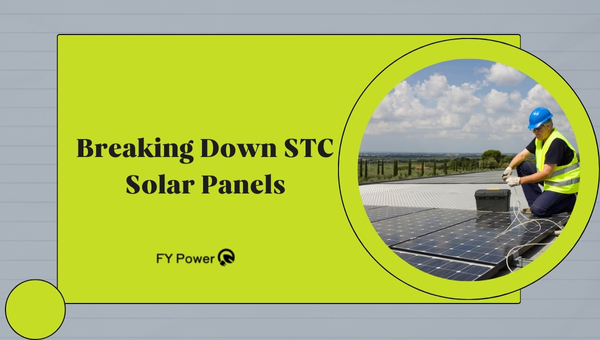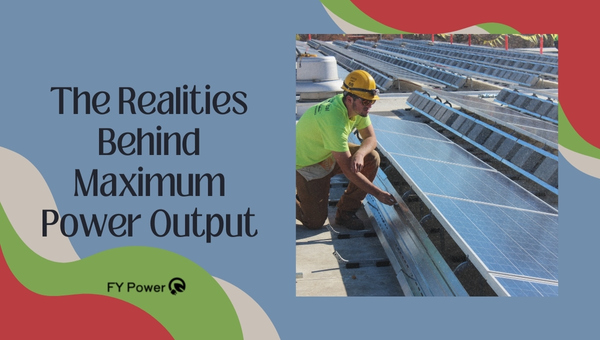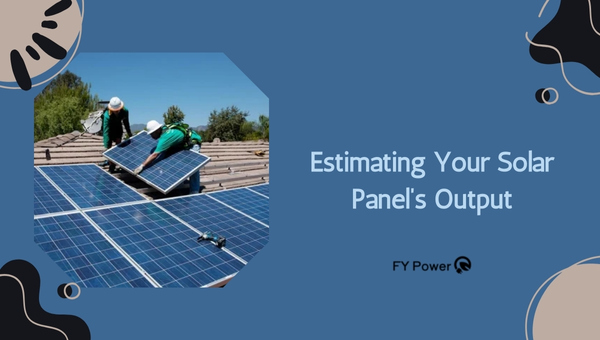When you’re peeking at the roof dotted with sleek solar panels, have you ever wondered how they rate their power? I’m here to brush up on what hid under the term “STC solar panels”. You see when we talk solar, it’s like comparing apples to apples—you need a common scale.
Standard Test Conditions or STC for solar panels do just that. It’s the secret handshake of panels, making sure when they say a panel can push out a certain chunk of power, it’s not just puffery—buckled in? Let’s dive into this sunny world!
Standard Test Conditions—or STC—create the ideal portrait of conditions under which all solar panels are tested for performance standards. Who doesn’t love basking in perfect sunshine? That’s precisely what engineers replicate indoors so that every panel gets its fair chance to shine free from cloudy days and surprise breezes.
At 25°C with only the sun on their face (well, an artificial sun), and no wind tickling their back – that’s when we get down to nitty-gritty numbers. Essentially, whether you clutch specs reading 200 or 400 watts, rest easy knowing each number is born from this cozy lab cradle environment.
Breaking Down STC Solar Panels
When I talk about solar panels, there’s a term that always comes up – STC solar panels. This stands for Standard Test Conditions. It’s a set of rules used to check a solar panel’s power. These rules help us compare panels fairly because every panel is tested the same way.

Defining Standard Test Conditions (STC)
STC means test rules to see how well a solar panel works. Imagine you’re running a race, but everyone has a different path—hard to tell who’s the fastest, right? Well, with STC for solar panels, the path is made equal for all, making it easy to see which panel performs best.
Why are STCs important? They let us look at different solar panels and compare them fairly. Without STCs, we would have messy data that wouldn’t tell us much about how one panel stacks up against another.
Here’s what happens during an STC test:
- A special light shines on the panel just like the sun.
- The room where this happens is kept very cool.
- The air around the panel doesn’t block too much light.
When companies make solar panels, they use these tests to say how strong their panels are. But remember – these tests happen inside under perfect conditions that aren’t quite like outside in real life. Still, they’re super helpful for giving us a base idea of what each panel can do.
Also Read: Power Consumption of Household Appliances
Components of STC Solar Panels
When we talk about solar panels, how do we know how much electricity they will make? We use something called Standard Test Conditions (STC) to measure this.
These are like rules or a recipe that tell us what conditions to test the panels under so that all solar panels are tested the same way. This helps us compare different solar panels fairly. Let’s look closer at some important parts of these testing rules: cell temperature, sunlight strength, and air mass.
Cell Temperature
What does cell temperature mean for solar panels? It’s the heat level of the cells in a panel when it’s being tested. Under STC, this temperature must be 25 degrees Celsius (77 degrees Fahrenheit). Why is this important?
Because the hotter the cell gets, the less power it makes. So when scientists want to check if a solar panel works well, they make sure it is this exact warm. This way, no matter where you are or what brand you buy, you know exactly how good that panel should be if it says it was tested with STC.
Solar Irradiance
Irradiance is just a fancy word for how strong sunlight is on your solar panel—like turning up a light bulb brighter and brighter in your room. During STC testing, sunlight strength needs to be 1,000 watts per square meter—it’s as if there is perfect sunshine hitting every inch of your solar panel!
If they used less sun power for one test and more for another test from another company… well that wouldn’t be fair or helpful to compare them!
Air Mass (AM)
Now here comes air mass—another funny term but an easy idea once I explain it. Think about looking straight up into the sky; light doesn’t have much atmosphere or “air” to travel through—that’s like Air Mass 1 (AM1).
But if you’re watching the sun when it’s rising or setting when light travels at an angle through more air—that could be AM2 or higher. Why does this matter? Well, more air can block some sun rays from reaching your panel so during STC tests we pretend there’s only AM1.5—kind of half-way—to make sure all tests are even and fair.
Remembering all these specific details might seem like extra work but knowing them means anyone can pick out really great STCs Solar Panels without worrying!
Also Read: What will a 3000 watt generator run
The Realities Behind Maximum Power Output
When we talk about solar panels, the term “maximum power output” pops up often. It’s the highest amount of electricity a panel can make under perfect conditions. This number helps us compare different solar panels to find out which one’s best.

But there’s a big difference between what we see on paper and what happens in real life. I’ll take a closer look at this to show you just how it works.
Measuring Maximum Power (Pmax)
The maximum power that a solar panel can produce, our Pmax, is key to understanding its strength. To measure this
- We use specific machines that mimic ideal sunlight.
- The machines keep the temperature constant at 25 degrees Celsius because that’s important for accuracy.
- They shine a light on the panel just like the sun would at noon on a clear day.
This way, we get the Pmax by seeing how much electricity comes out when conditions are perfect.
Pmax Under Standard Test Conditions
Now, STC or Standard Test Conditions set up an even playing field to measure solar panels.
- They say you have to use sunlight strength of 1000 watts per square meter.
- Temps must be held at exactly 25 degrees Celsius or about 77 degrees Fahrenheit.
- Also, they take into account something called air mass which should be 1.5.
This is like taking all solar panels on their best day ever and seeing which does better when they’re all given equal sunshine and no clouds in sight.
Real-World Power Output Vs. Pmax
But here’s the thing: these ideal lab measurements are different from what happens outside—at your home or mine.
- If it gets hotter than 25 degrees Celsius outside, performance drops—not good.
- What’s more? The actual amount of sunlight can vary—clouds enter, seasons change—it all affects the real power output differently than in testing labs.
Using STC helps compare panels but remember this; it won’t tell you exactly what you’ll get once your panel faces real weather back home or at your business place.
Delving Into Operational Temperatures
When we talk about solar panels, how much electricity they make depends a lot on the weather. Just like we get hot in the summer and cold in the winter, solar panels act differently when temperatures go up or down.
So, I’m going to tell you about a special kind of temperature called NOCT that helps us understand how solar panels will do when they’re up on our roofs and not in perfect lab conditions.
Understanding Nominal Operating Cell Temperature (NOCT)
NOCT stands for “Nominal Operating Cell Temperature,” and it’s a way to guess what temperature solar panel cells will reach on an average day. It’s not too hot or too cold – just an average that we can use to measure things evenly.
Here’s what they use for NOCT:
- They start with 20 degrees Celsius outside air temperature.
- No one is tilting or turning the panel—just 45 degrees to the sun.
- A little bit of wind blowing past but not much—just enough to feel it if you put your hand out.
- The amount of sunlight is as strong as if it were a nice spring day—not too cloudy and not too sunny.
So that gives us a number in Celsius telling us how hot the cells would be under those normal conditions—I think of it like finding the comfy setting on your AC at home.
Influence on Performance
Now, let me explain why NOCT matters:
- Real Heat vs Lab Heat: In tests, labs use STC which means standard test conditions—but we already know real life isn’t always standard! With NOCT, we get closer to figuring out how much power our panels will actually make when they’re outside in real weather.
- Cool Panels Make More Power: Panels like being cool over being hot; they make more electricity that way. When they get hotter than their NOCT level due to very sunny days or lack of wind, their power-making ability drops off some.
- Long-Term Planning: Knowing your solar panel’s NOCT helps plan better—for example, knowing if I’ll have enough power for my air conditioner during those super-hot July days.
Impactful Metrics in Evaluating Panel Efficiency
When we look at how well solar panels work, there are certain things we can measure to see if they’re good or not. One important thing to check is how the panel’s power-making ability changes with temperature. This can tell us a lot about the panel’s quality and how it will do when it’s really hot or cold outside.
Exploring the Temperature Coefficient of Pmax
The temperature coefficient of maximum power (Pmax) is a big deal when you’re talking about solar panels. Think of this as a number that shows how much the power output from a solar panel goes up or down when the temperature changes by one degree.
Usually, you’ll see this number written like “-0.3%/°C”. What this means is, that for every degree above a set point, often 25°C, the max power that panel can make will be 0.3% less.
To get why this matters, imagine on a very hot day or in places where temperatures soar high above that set point of 25°C (which is like an average room temperature).
The hotter it gets, the less electricity your panel is going to pump out because its efficiency drops due to heat – and vice versa for cooler temps but there’s less sun then anyway!
How Does It Affect Panel Performance?
So now you know what the temperature coefficient is all about – let me explain how these ups and downs impact your solar system’s overall oomph factor.
If your panel has a high negative number for its coefficient (like say -0.5%/°C), then you might notice that during those steamy summer days, your lights might not be as bright and your fridge isn’t keeping those drinks quite as icy cold.
On the flip side though, if it’s lower (a smaller negative value), your solar setup won’t sweat the small stuff so much when the heat cranks up – still cranking out more juice compared with others under the same scorching sun.
Keep in mind, though! A striking low-temperature coefficient doesn’t make up for poor performance in other areas. It has to go hand in hand with other specs – like STCs – Standard Test Conditions, remember?
That’s where all manufacturers sing the same tune using common benchmarks so we users get what all numbers truly mean… apples to apples style comparison!
Estimating Your Solar Panel’s Output
To know how much power your solar panel might make, you don’t need to be an expert. It’s like guessing how much fruit a tree will give by just looking at it. You check the leaves, the place of the tree, and how often it gets water.

For solar panels, there are simple ways to guess their power. This is important if you want to manage your electricity better or if you’re going to show off how green you are.
How to Estimate Solar Panel Power Output?
When trying to figure out your solar panel’s power output, details matter a lot. Each piece of the puzzle helps paint a clearer picture of what you can expect from your panels on bright sunny days or even when it’s not so sunny.
Firstly, look at the rating of your panel under STC – that is their best-case scenario number in perfect lab conditions. But remember that these numbers might be a bit optimistic compared with real life because weather and where they’re put can change things.
Secondly, get familiar with something called STC parameters which include things like light intensity hitting the panel (called ‘irradiance’), the temperature of the cells in the panel (not too hot or cold), and what condition our atmosphere is in (‘air mass’).
Understanding these conditions can help you read between the lines and not just take those shiny numbers at face value.
A Step-by-Step Guide
Now let’s roll up our sleeves and jump into a step-by-step guide for making an educated guess about your solar panels’ power output:
- Identify Your Panels’ Rated Power: Look at your solar panel specs sheet or label for something called ‘Max Power’ or ‘Pmax.’ That’s its peak performance in ideal-world scenarios.
- Adjust for Real-World Conditions: Take into account where they’re located — tilt angle towards the sun matters; north-facing won’t work as well as south-facing in most northern hemisphere locations.
- Consider Local Weather Patterns: Be realistic about sun availability – cloudy areas produce less than deserts.
- Factor In Seasonal Changes: Remember summer has more sunshine hours than winter.
- Calculate Energy Losses: System losses from wires and connections happen – usually around 5% to 20% loss depending on setup quality.
- Use Online Calculators: If this feels too complex, online tools can do some heavy lifting using all kinds of smart math based on lots of data points.
After finishing up these steps, what do you have? A much better idea of what electric juice to expect flowing from those shiny glass sheets on top of your roof!
FAQs
What’s the difference between NOCT and Cell Temperature under STCs?
NOCT, or Nominal Operating Cell Temperature, refers to the expected panel temperature in real-use conditions. On the other hand, cell temperature under STC solar panels represents a standard testing benchmark at 25°C to rate panels.
Can I expect my home’s solar panels to perform at their rated Pmax?
In reality, your home’s solar panels will often operate below their rated Pmax because real-world conditions vary greatly from Standard Test Conditions. Factors like shading, dust, and temperatures influence performance.
How does AM affect my daily power generation?
AM stands for Air Mass and is related to how much atmosphere sunlight must pass through before hitting your panels. The higher the AM value, as happens during morning or evening times, the less intense sunlight may be and thus potentially lower daily power generation.
Conclusion
As I wrap up, it’s clear that Standard Test Conditions or STC for solar panels serve as a crucial benchmark for understanding and comparing solar panel performance. These conditions, which set the precise parameters under which all solar panels are tested, including cell temperature, solar irradiance, and air mass among others, give us a standardized way to gauge panel efficiency and expected power output.
It’s important to remember that while STC provides valuable data about a panel’s peak performance under optimal conditions, the real-life energy yield will vary. Factors such as shadowing from trees or buildings, dirt accumulation on the panels, and regional climate differences can all impact the actual power output.
That’s why understanding real-world conditions alongside STC metrics is vital when evaluating solar panel options for your specific needs.

